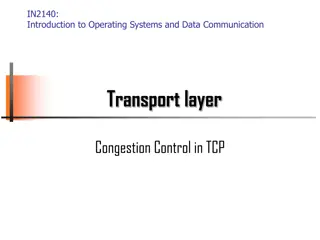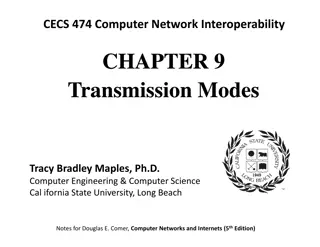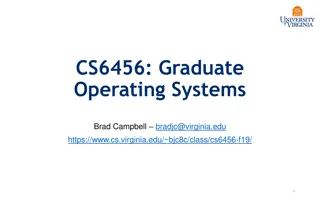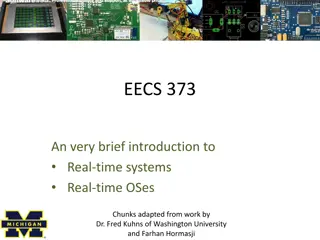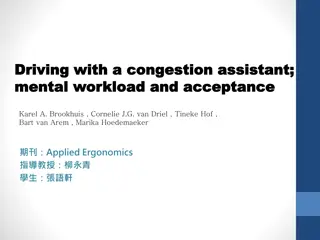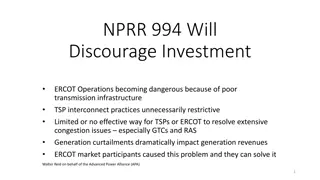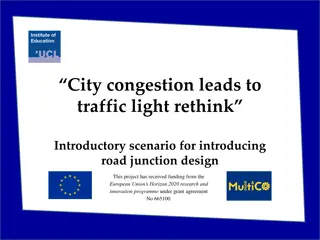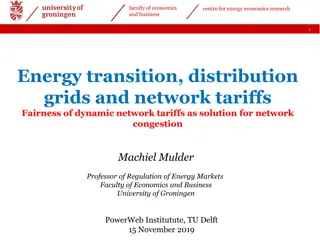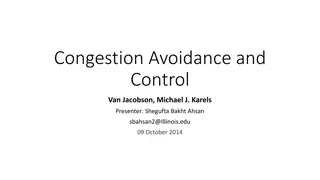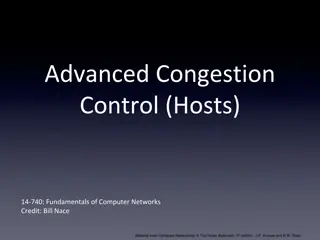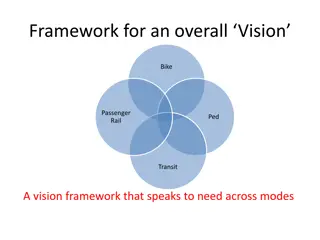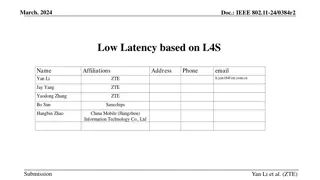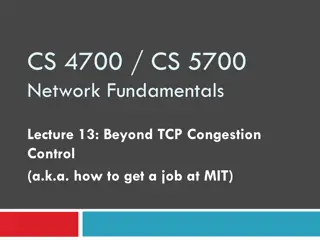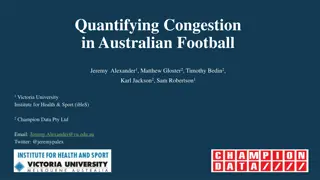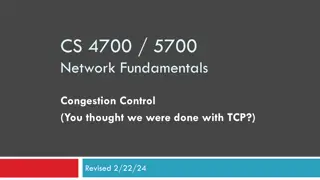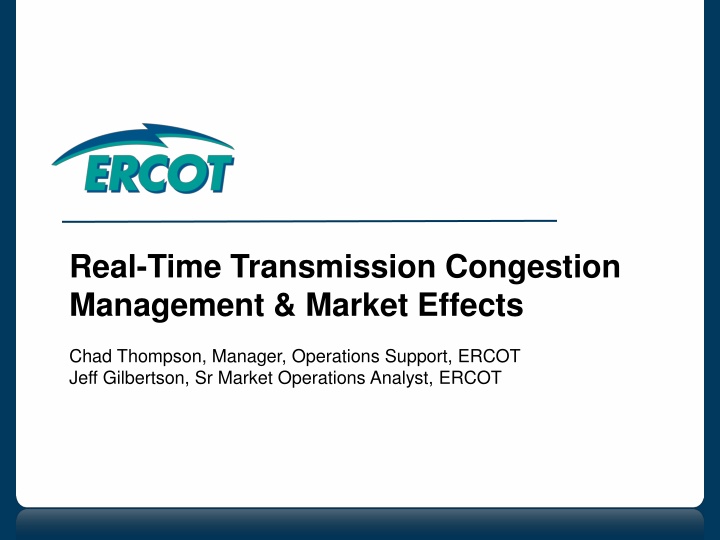
Real-Time Transmission Congestion Management
This content delves into the intricate processes of managing real-time transmission congestion in the ERCOT system, discussing constraints, congestion basics, and operational protocols. Learn about Constraint Management Plans, applications for resolving constraints, and the criteria for handling contingencies in the system.
Download Presentation

Please find below an Image/Link to download the presentation.
The content on the website is provided AS IS for your information and personal use only. It may not be sold, licensed, or shared on other websites without obtaining consent from the author. If you encounter any issues during the download, it is possible that the publisher has removed the file from their server.
You are allowed to download the files provided on this website for personal or commercial use, subject to the condition that they are used lawfully. All files are the property of their respective owners.
The content on the website is provided AS IS for your information and personal use only. It may not be sold, licensed, or shared on other websites without obtaining consent from the author.
E N D
Presentation Transcript
Real-Time Transmission Congestion Management & Market Effects Chad Thompson, Manager, Operations Support, ERCOT Jeff Gilbertson, Sr Market Operations Analyst, ERCOT
Objectives Identify what defines a constraint in the ERCOT system. Identify which ERCOT application dispatches generation to resolve constraint overloads. Identify the types of Constraint Management Plans as detailed in the ERCOT Nodal Protocols. 2
Objectives Identify the time-frame in which all Congestion Management Plans are intended to resolve loading below Emergency Ratings. Identify where Congestion Management Plans are posted to the Market Identify the ERCOT application whose goal is to minimize generation costs while also respecting transmission constraints. 3
Objectives Identify when the transmission network is invisible to Security Constrained Economic Dispatch (SCED). Identify the condition when a constraint Shadow Price is zero dollars ($0) 4
Congestion Management: Real-Time Chad Thompson 5
Congestion Basics Equipment Ratings Normal/Continuous Emergency/2-Hour Loadshed/15-Minute Dynamic Line Ratings Temperature-adjusted based on ambient temperature TSPs submit a static ratings table that is tied to the ERCOT weather forecast TSPs also have the option to submit a rating via ICCP telemetry MVA, Amps, Temperature All Autotransformers and Transmission lines have 3 ratings in the model; some may be the same 6
Congestion Basics ERCOT Operates to N-1 Contingency Criteria Contingencies include the loss of Autotransformers, Transmission Lines and Generation Units N-1 congestion *generally* based on the Emergency Rating Base Case congestion based on the Normal Rating What is a constraint? An N-1 contingency and overloaded transmission element pair A base case, or real-time transmission element overload 8
Constraint Management How are constraints identified? ERCOT executes its State Estimator and performs a Real-Time Contingency Analysis (RTCA) every 5 minutes RTCA produces a list of constraints which is updated every time it executes How are constraints used? ERCOT executes a Security Constrained Economic Dispatch (SCED) market every 5 minutes SCED dispatches generation to resolve constraint overloads Only those constraints passed from RTCA into SCED are considered in congestion management 9
Constraint Management Only those constraints passed from RTCA into SCED are considered in congestion management Does this mean that not all constraints are activated? What are the criteria for activating constraints? Correct modeling, telemetry, & solution Not redundant Not Private Use Network Equipment 2 % or greater Generator Shift Factor* Constraint Management Plans (CMP) 10
Constraint Management How can I find out why a constraint was not activated? MIS Secure Area under Grid Transmission Real-Time Operations 11
Constraint Management What s a Constraint Management Plan? A transmission switching action that is developed to ensure overall grid reliability in the event a given contingency occurs CMPs are intended to supplement SCED, while maximizing transmission capacity when possible 12
Constraint Management What s a Constraint Management Plan? Currently 4 types of CMPs as detailed in Section 2.1 Definitions of the ERCOT Nodal Protocols Mitigation Plan Pre-Contingency Action Plan (PCAP) Remedial Action Plan (RAP) Temporary Outage Action Plan (TOAP) All CMPs are intended to resolve loading to below Emergency Ratings, with restoration of normal operating conditions within two hours 13
Constraint Management Mitigation Plan Post-contingency actions May include load shed Constraints managed to their Emergency Ratings Not Modeled in ERCOT Systems Pre-Contingency Action Plan (PCAP) Pre-contingency actions Do not include load shed Constraints managed to their Emergency Ratings Not Modeled in ERCOT Systems 14
Constraint Management Remedial Action Plan (RAP) Post-contingency actions Do not include load shed Constraints managed to their 15-Minute Ratings Modeled in ERCOT Systems Temporary Outage Action Plan (TOAP) Post-contingency actions May include load shed Constraints managed to their Emergency Ratings Not Modeled in ERCOT Systems Mitigation Plan for the duration of an outage 15
Constraint Management Contingency Details Administrative Details Overloaded Elements Corrective Actions Additional Details 16
Constraint Management Where are CMPs Posted? MIS Secure Area under Grid Long-Term Planning Special Protection Systems and Remedial Action Plans 17
Congestion Management: Market Effects Jeff Gilbertson 18
Topics Covered Security Constrained Economic Dispatch (SCED) inputs and outputs Constraint Scenarios Data relationships 19
SCED Inputs and Outputs Security Constrained Economic Dispatch (SCED) Goal: Minimize generation cost while also respecting transmission constraints ( security constrained ) Inputs Generation to be Dispatched (GTBD) Generator offer curves Generator limits (Low/High Dispatch Limits) Generator current power output Active transmission constraints (cont d) 20
SCED Inputs and Outputs Active transmission constraints Contingency and monitored element pair names Monitored element ( constraint ) post-contingency flow Constraint limit Maximum shadow price Resource shift factors This is all SCED knows about the ERCOT transmission network! 21
SCED Inputs and Outputs Transmission Constraint Shadow Price (SCED output) Change in cost of system dispatch for a 1 MW change in monitored element limit Maximum Shadow Price (SCED input) Prevents wide price spread when constraint is not resolvable or very difficult to resolve $5,000 $3,500 BASE CASE 138 kV $4,500 $2,800 345 kV 69 kV 22
SCED Inputs and Outputs Resource Shift Factor Change of flow on monitored element due to 1MW change of output of Resource Value range: -1 to 1 Positive shift factor : flow on monitored element increases as generation increases Negative shift factor: flow on monitored element decreases as generation increases 23
SCED Inputs and Outputs Resource Shift Factor Magnitude of shift factor indicative of number of paths Resource output has to flow Greater magnitude shift factors: Resource located on a radial path from monitored element; and/or Resource located close to monitored element 24
SCED Inputs and Outputs Outputs Resource Base points (sent only to Resource) Locational Marginal Prices (LMPs) cost to serve additional 1MW of load at a location Consistent with base points LMP higher than offer curve price, base point instructs resource to increase output LMP lower than offer curve price, base point instructs resource to decrease output Constraint solution flow 25
SCED Inputs and Outputs Where is SCED constraint data posted? MIS Secure Area under Markets Real-Time Market 26
Constraint Scenarios No active constraints Transmission network invisible to SCED Dispatch is like using an offer stack Resources dispatched to meet GTBD Less expensive resources fully dispatched to High Dispatch Limit (HDL) More expensive resources dispatched to Low Dispatch Limit (LDL) Resources in between LDL and HDL are marginal and set one system-wide Locational Marginal Price (LMP) No congestion costs 27
Constraint Scenarios Active constraint(s) that are not binding in SCED By dispatching inexpensive resources first, the resulting post-contingency flow on constraints is less than limit No congestion costs; one system-wide LMP Again, dispatch is like using an offer stack 28
Constraint Scenarios Active constraint(s) that are binding in SCED Dispatch based on economics alone would result in post-contingency flow above transmission limit More expensive resources must be dispatched higher and less expensive resources dispatched lower in order to respect the limit Flow change on constraint is (solution resource output initial resource output) * shift factor for each resource Power balance must be maintained, so resource level adjustments must balance each other out 29
Constraint Scenarios Active constraint(s) that are binding in SCED Binding constraints have a non-zero shadow price The shadow price is the price sensitivity of the transmission constraint If transmission limit was 1MW lower, what would that mean in terms of cost? Since we are already starting at the most economic solution at the limit, the less expensive resources would need to produce less and more expensive resources would need to produce more Results in different LMPs throughout the system 30
Constraint Scenarios Active constraint(s) that are violated in SCED Transmission limit is NOT respected Occurs because: there are no resources that can be dispatched to resolve the constraint the cost to resolve the constraint is very high Remember, flow is post-contingency flow. Actual monitored element flow is not allowed to go above limit. 31
Constraint Scenarios Conditions for transmission congestion At least one transmission constraint is active SCED dispatch results in post-contingency flow on the monitored element at or above the constraint limit 32
Data Relationships Relationship between constraint flow and constraint shadow price Scenario Not binding Binding Irresolvable/ violated Flow < limit = limit > limit Shadow Price $0 > $0 and < Max SP Max Shadow Price 33
Data Relationships Relationship between shadow price, shift factors, and LMP LMP = System Lambda - (shift factor * shadow price) - (shift factor * shadow price) (shift factor * shadow price) subtracted for each constraint 34
Data Relationships Example: System Lambda is $50 Resource A has a shift factor of 0.2 to constraint A Constraint A shadow price is $100 LMP = System Lambda (shift factor * shadow price) LMP = $50 (0.2 * $100) = $50-$20 = $30 35
Questions? 36
Questions 1. A constraint in the ERCOT system is defined as a) An N-1 contingency and overloaded transmission element pair b) A base case, or real-time transmission element overload c) All of the above 37
Questions 2. Which ERCOT application dispatches generation to resolve constraint overloads? a) SCED b) RTCA c) VSAT d) VSS 38
Questions 3. Which of the following Constraint Management Plans are detailed in the ERCOT Nodal Protocols: a) Mitigation Plan (MP) b) Pre-Contingency Action Plan (PCAP) c) Remedial Action Plan (RAP) d) All of the above 39
Questions 4. Within what time-frame which all Congestion Management Plans are intended to resolve loading below Emergency Ratings? a) 2-hours b) 4-hours c) 24-hours d) Doesn t matter as long as resolved 40
Questions 5. Where are Congestion Management Plans posted to the Market? a) MIS Restricted b) MIS Public c) MIS General d) MIS Secure 41
Questions 6. Which ERCOT application s goal is to minimize generation costs while also respecting transmission constraints? a) GTBD b) RTCA c) SCED d) SASM 42
Questions 7. Under what condition is the transmission network invisible to Security Constrained Economic Dispatch (SCED)? a) No Active Constraints b) Active Constraints c) Binding Constraints d) Non-Binding Constraints 43
Questions 8. Under what condition would a Shadow Price of zero dollars ($0) be calculated? a) Constraint flow is < limit b) Constraint flow is = limit c) Constraint flow is > limit d) None of the above 44



